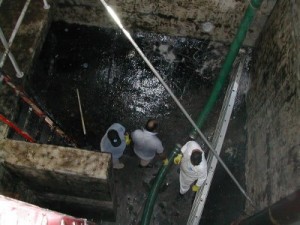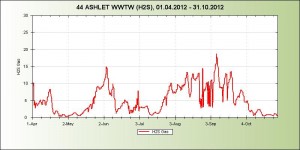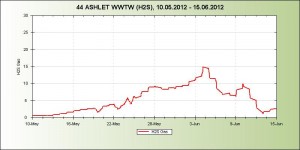Case Studies
Hydrogen Sulfide Control in a Municipal Sewer Collection System
Odor and Corrosion Control in Pump Stations Using Microcat ® – ANL BioBlend – BSE 104
Problem
Hydrogen sulfide generated in sewer systems can cause safety and maintenance problems including toxicity to humans, odors and corrosion. Several methods are used to control hydrogen sulfide in collection systems. While many have proven to be at least partially effective, they can be quite costly and require constant attention in order to exert sufficient control to keep the costs to a minimum without sacrificing performance.
In these lift stations the hydrogen sulfide levels were such that under certain conditions the installed chemical control technique in use could not keep up with the chemical demanded and hazardous sulfide hazard levels in the air could not be avoided from time to time. Chemical dosing could be increased, but the response was slow and the costs were deemed to be excessive. Therefore, a better, less expensive and more environmentally sound control method was sought.
The objective of this program is to determine the effectiveness of applying Microcat-ANL microbial sulfide controller for keeping the hydrogen sulfide levels below 10 ppm in the air at a full-scale pump station. If the application proved effective, then a further objective was to determine how much could be saved using the MICROCAT product in comparison to the chemical product in use.
Application Procedure
Based on the sewer system layout, length of sewer lines from Pump Station 1 and Pump Station 2 to Pump Station 3 , daily average flow rate and hydraulic retention times, a dosing scheme was designed to inoculate Pump Stations 1 & 2, which lead to Pump Station 3.
Pump Station 1:
Start-up dosing during 5 days: 0.05 Gallons/day (0.177 L/day)
Maintenance dosing following the start-up period: 0.02 Gallons/day (0.089 L/day)
Pump Station 2:
Start-up dosing during 5 days:
1 Gallon/day (3.79 L/day)
Maintenance dosing following the start-up period: 0.5 Gallons/day (1.89 L/day)
Dosing started on the 16th of April and occurred 2 times a day by using programmable peristaltic dosing pumps. The only required additional equipment at both application points was a 5 gallon (approximately 20 L) product container and a dosing pump. Microcat-ANL is stable and non-hazards us, so no special storage conditions or safety precautions needed to be taken.
On the 15th of May dosing was switched off the see if the treatment had any kind of prolonged effect after product application stopped. On the 22nd of May it was switched on again.
Results and Conclusions
The first graph below displays H2S levels measured at Pump Station 3 from the 1st of April to the 31st of October. The graph displays the hourly average H2S concentration. The second graph shows the H2S development at Pump Station 3 during the period of interrupted dosing of the Microcat-ANL. H2S levels stay below the 10 ppm limit during most of the evaluation period. During the period of interrupted dosing, 15 to 22 May, H2S levels increased slowly until the 5th of June when the ANL treatment was fully reactivated, and H2S levels started to come down again.
From the middle of July significantly warmer weather started which lasted up to the middle of September and this pushed H2S levels up. However, for most of this period H2S levels stayed below 10 ppm. On several instances H2S levels rose over 10 ppm but stayed close to the 10 ppm target and reverted to the target quickly without increasing the dosing of the MICROCAT product.
The second graph focuses on the period during which the application of MICROCAT – ANL was purposely turned off (May 15 to May 22) and the response when it was restarted on May 23.
The Microcat-ANL application program demonstrated that biological H2S control is a viable method of controlling the emission of sewage gas and can keep H2S levels within acceptable safety and corrosion limits.
As the dosage volume of the product is on a constant set amount and not controlled by H2S loggers, the annual product consumption can be easily calculated beforehand, thus eliminating the possibility of exceeding the allocated budget for the H2S control. Microcat-ANL is non-hazardous, so storage conditions can be relatively simple and there is no risk to workers on site.
The Microcat-ANL consumption during the trial period was a total of 100 gallons (382 L) including the 5 day start-up. Due to the interruption of dosing in May an additional 5 gallons (19.8 L) of Microcat-ANL was used to start up again. A full year of dosing Microcat-ANL treatment would consume 182 gallons (722 L), not including the start-up dose. Thus, an annual Microcat-ANL cost is about 50% less than the chemical program currently in use.
Based on applications of Microcat-ANL at other locations there are additional benefits at the downstream wastewater treatment plant when Microcat-ANL is used in the collection system. Reduced dissolved oxygen (DO) requirement, improved solids settling, reduced odour from primary clarifiers and sludge dewatering have been documented. These improvements in performance lead to additional operating cost savings.


